Figures & data
Figure 1. Examples of Giant Quartz Veins cropping out in different tectonic settings: (A) the Esquerdes de Rojà vein in the Canigó Massif, pre-Variscan basement of the Pyrenees, SW Europe; (B) the Poolamacca veins in the Broken Hill Inlier, western New South Wales, Australia (from CitationBons, 2001); (C) the China Wall vein in the Halls Creek Belt, north Western Australia, Australia; (D) the Castle Ruin Weissenstein vein in the Bavarian Phal Zone, Bohemian Massif, Central Europe (from the Naturpark Bayerischer Wald administration); and (E) the Heyuan vein in the Shaowu-Heyuan Fault zone, South China block (from CitationTannock et al., 2020).
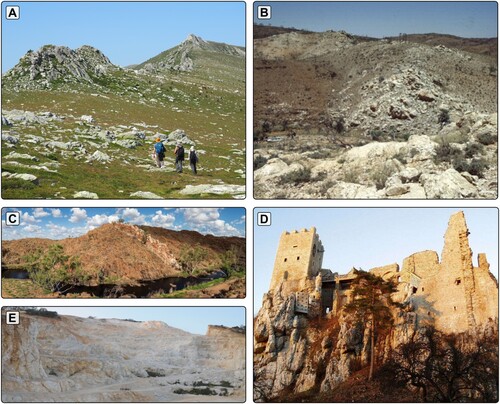
Figure 2. (A) Geological sketch map of the Pyrenees showing the distribution of giant quartz veins and the location of the study areas located in La Cerdanya (B), Cap de Creus (C), and Roc de Frausa Massifs (D) (orthophotographs from the Institut Cartogràfic i Geològic de Catalunya – ICGC).
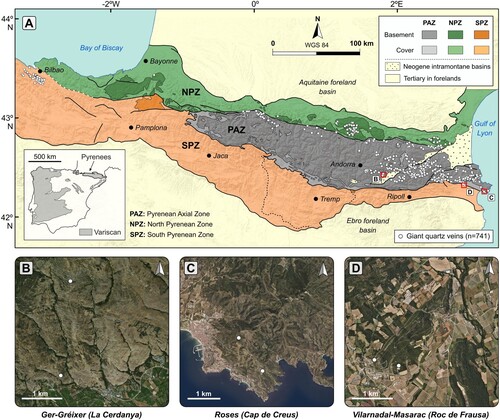
Figure 3. Field photographs of the host rocks from the Ger-Gréixer sector: (A) Typical aspect of the dark-blueish shale layers of the Err Fm. showing a marked LS2/S0 intersection lineation; (B) Discontinuous level of black shales that represents the boundary between the Olette and Serdinya Fms.; (C) Typical example of the greenish sandstone and shale layers of the Serdinya Fm.; (D) Quartzite layers of the Font Frède Mb. strongly folded in the southern (reverse) limb of a major anticline fold; (E) Cut and polished sample of the Err Fm. showing the strongly folded bedding surfaces (S0) and a poorly developed slaty cleavage (S1); (F) Host rock silicification area linked to one of the south-directed thrusts faults present in the study area, which postdate the development of the main cleavage S2; (G) Apophysis-like texture (white arrow) and host rock silicification aureole ca. 2 m away from the giant quartz vein located at the northern sector of the study area; (H) Detail of the GQV boundary showing highly silicified adjacent host rocks of the Serdinya Fm. (I) Detail of the vein located at the southern sector of the study area, showing host rock fragments that preserve the original trend of the main S2 surfaces and are crosscut by cm-wide veins.
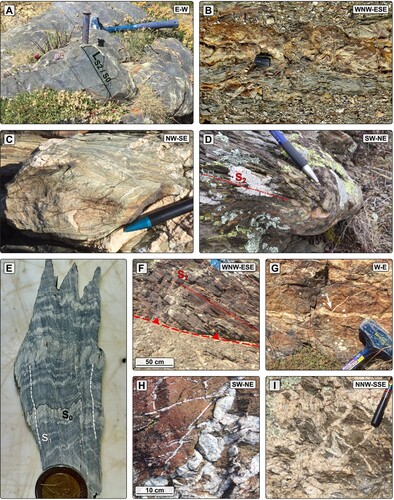
Figure 4. Field photographs of the host rocks from the Roses sector: (A) Strongly folded bedding surfaces of the fine-grained metasedimentary rocks; (B) metavolcanic rocks intercalated within fine-grained metasediments crosscut by pinch-and-swell (occasionally boudinated) quartz veins; (D) Coarse-grained metasediments showing a NW-SE-oriented main cleavage (S1) and a SW-NE-oriented crenulation cleavage (S2); (E) Roses granodiorite showing 2 cm-wide shear bands parallel to the main cleavage (S2; gneissic foliation); (F) Zone of major deformation within the silicification area of the NW segment of the Roses giant quartz vein, showing deformed quartz veins that crosscut the coarse-grained metasediments; (G) Silicified and sheared quartz-schist band located a few metres away from the NW segment of the Roses giant quartz vein; (H) Giant quartz vein-host rock contact zone showing cm-wide quartz veins with apophysis-like textures; (I) and (J) Host rock fragments within the main quartz mass preserving the orientation of the main cleavage (S2); (K) Vein-parallel stylolite networks (red arrows) and highly-silicified host rocks at the contact zone between the SE segment of the Roses vein and the fine-grained metasediments; (L) Detail of the SE segment of the Roses vein showing a network of cm-wide crack-seal veins crosscutting a blueish-greyish quartz mass that records traces of the original fabric of the metasedimentary host rocks.
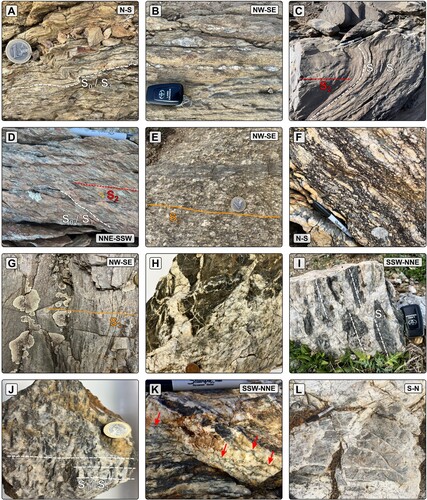
Figure 5. Field photographs of the host rocks from the Masarac-Vilarnadal sector: (A) unaltered granodiorite from the St. Llorenç-La Jonquera pluton; (B) altered granodiorite that is crosscut by 2 cm-wide quartz veins; (C) micritic limestone of the Mid Triassic lower Muschelkalk facies; (D) calcite vein networks close to the hinge zone of a NW-SE-oriented anticline in the Mid Triassic lower Muschelkalk facies; (E) SW-NE-oriented bedding surface of the Upper Cretaceous conglomerates showing a NW-SE-oriented sub-vertical cleavage; (F) silicification area with cm-wide quartz veins within the Upper Cretaceous-Paleocene lower Garumnian facies; (G) Syncline-anticline NW-SE-oriented folds affecting the Upper Cretaceous ochre limestones; (H) Embryonic replacement textures of host rocks in the Upper Cretaceous conglomerates close to the giant quartz vein (see location on D); (I) and (J) detail of a giant quartz vein with visible remnants of the replaced conglomerate fabric (see location on J).
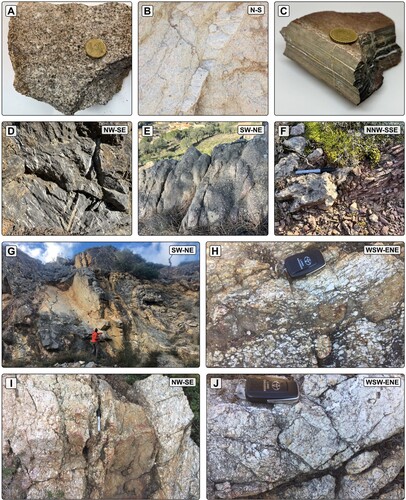
Figure 6. (A) The giant quartz vein located at the northern sector of the Ger-Gréixer area, emplaced along a ca. 50° N-dipping thrust fault; (B) UAV (Unnamed Aerial Vehicle) aerial photograph of the NW segment of the Roses vein, where it was emplaced along a ca. 50–70° SW-dipping silicified and sheared quartz-schist band; (C) The SE segment of the Roses vein, where it was emplaced along a ca. 40–55° SW-dipping thrust fault; (D) Digital Elevation Model coupled with aerial photographs acquired using an UAV of a giant quartz vein (white arrows) from the Vilarnadal-Masarac area.
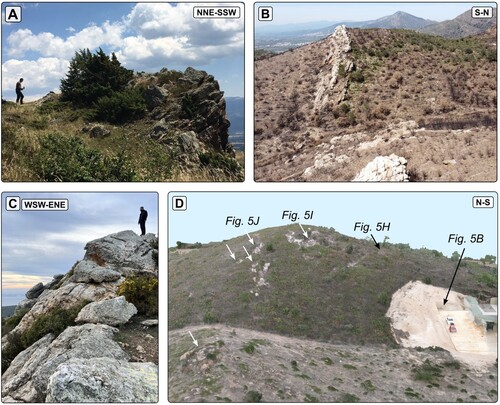
Figure 7. Representative cross sections of the Ger-Gréixer (A), Roses (B) and Vilarnadal-Masarac (C) sectors. See Main Map, Figures C, D and E for location.
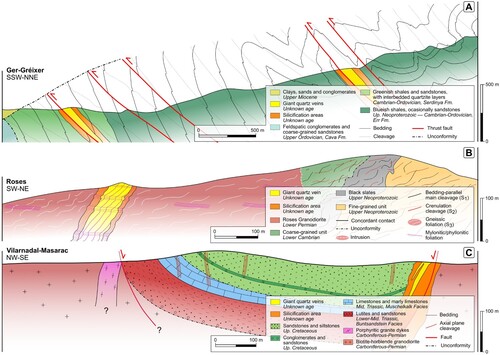
Supplemental Material
Download Zip (2.7 MB)DATA availability statement
The authors confirm that the data supporting the findings of this study are available within the article and its supplementary materials.

